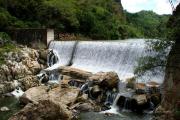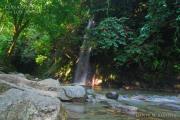Spanish-style lamp posts, cobbled streets, adobe walls, clay pots and planters… Walk along the streets of the Historical Corridor in the Old District of Las Piñas and get a glimpse of the colonial past. Be transported back in time as you see historic and cultural landmarks that highlight the charming aspects of our Spanish heritage.
Walk down memory lane...
In the heart of the thriving city of Las Piñas, you will find a number of restored buildings and structures, one of which is the Boundary Arch that marks the border between the neighboring cities of Las Piñas and Parañaque. The design of the arch is similar to that of intertwined bamboo, but is actually made out of steel and concrete. The bamboo-inspired design is believed to symbolize the strength and resilience of Filipinos.
The project also includes the development of a Historical and Cultural Museum, which is a gift of Rep. Villar’s family to the residents of Las Piñas. This museum will act as the historical and cultural center of the city, which will uphold its vision in the years to come.
Spanish colonial architecture will also be reflected in other sites such as the New District Hospital, Manpower School, Police and Fire Station, Daniel Fajardo Hall, Public Library, Irasan Center (where the salt-making tradition is showcased), Gabaldon Hall, and the Fr. Diego Cera Bridge.
Historic sites such as the Zapote Bridge is also part of the restoration project, as it will serve as a reminder of the courage and valor of Filipino revolutionaries, led by General Edilberto Evangelista, during the bloody battle for freedom. The Plaza Quezon is another historical landmark that has witnessed a myriad of political rallies and other significant events. It is now converted into a park where people can come together and spend a day of leisure in its pleasant surroundings.
Spanish-inspired design is also apparent in the sidewalks, bollards, white lamp posts, and even the garbage cans. These can all be seen along the Fr. Diego Cera Avenue, a major thoroughfare in the city. One of the country’s premier architects, Francisco “Bobby” Mañosa, is involved in the project and has already created preliminary designs for it. The Las Piñas Historical Project truly reflects the glorious past of the Philippines, and is a definite source of pride for all Filipinos.
Getting Around
Take a bus that goes to Alabang via EDSA. Get off on Zapote road and catch a jeep going down Alabang-Zapote to Las Piñas.
Accommodations in the city are also available. There are lots of inns and hotels throughout the town offering comfortable rooms and cottages at a reasonable price.
• Acacia Hotels Manila - 5400 East Asia Drive, Alabang / Filinvest, Manila, Philippines 1781
• Marriott Hotel Manila - 10 Newport Boulevard, Newport City Complex, Pasay, , Pasay Airport Area, Manila, Philippines 1309
• The Bellevue Manila - North Bridgeway, Northgate Cyberzone, Filinvest Corporate City, Alabang, Muntinlupa City,, Alabang / Filinvest, Manila, Philippines
• Vivere Hotel - 5102 Bridgeway Ave. Filinviest Corporate City, Alabang Muntinlupa City , Alabang / Filinvest, Manila, Philippines
• Maxims Hotel - Newport Boulevard, Pasay, Pasay Airport Area, Manila, Philippines
• Heritage Hotel - Roxas Boulevard corner EDSA, Pasay City, Pasay Airport Area, Manila, Philippines
• Midas Hotel - 2702 Roxas Boulevard, Pasay Airport Area, Manila, Philippines
• Remington Hotel - Maxims Tower, Resorts World Manila, Newport Boulevard, Newport City, Pasay Airport Area, Manila, Philippines
• Microtel Hotels & Resorts Mall of Asia - Coral Way Ave cor Seaside Boulevard, Mall of Asia Complex, Manila Bay, Manila, Philippines 1308
• Copacabana Apartment Hotel - 264 Edsa Extension, Pasay Airport Area, Manila, Philippines 1302










